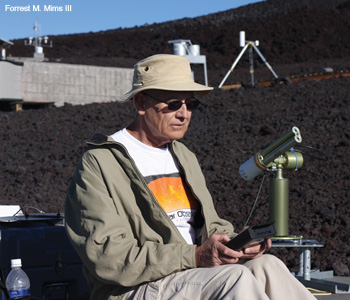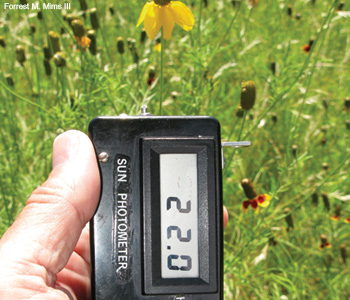 The
author uses an LED Microtops II next to a Cimel robotic sun photometer
at Hawaii’s high altitude Mauna Loa Observatory. Five LEDs replace the
usual photodiodes and filters in the Microtops shown here.
The
author uses an LED Microtops II next to a Cimel robotic sun photometer
at Hawaii’s high altitude Mauna Loa Observatory. Five LEDs replace the
usual photodiodes and filters in the Microtops shown here.
The
history of sun photometry—the practice of measuring atmospheric
aerosols and water vapor by detecting sunlight—traces back at least a
century. Traditional photometers detect sunlight using optical
interference filters and broadband silicon photodiodes. But while
silicon photodiodes are very stable and have low temperature
sensitivity, the filters are expensive and can be subject to
unpredictable drift or degradation that can severely affect the quality
of measurements.
In 1989, I devised a filterless method
for measuring sunlight by using light-emitting diodes (LEDs) as
spectrally selective photodiodes—a design that greatly improves the
long-term stability of sun photometers. The first LED sun photometer,
which was assembled from components that cost less than $50, exhibited
minimal calibration drift over two decades.
The device
incorporates two near-IR LEDs, one of which detects the 940-nm water
vapor absorption band and the second of which detects a nearby
reference band. Since February 1990, the ratio of the signals from
these LEDs has provided the total column abundance of water vapor over
my South Texas site at solar noon to within 3 percent of the mean of
3.5 years of more recent measurements made by the nearest GPS receiver
in the National Oceanic and Atmospheric Administration’s (NOAA) GPS
Integrated Precipitable Water project. Measurements of the atmosphere’s
aerosol optical density (AOD) can be made with similar accuracy.
Here,
I provide a history of handheld sun photometry; recount the development
of LED sun photometry and radiometry; and provide some resources for
scientists, educators, students and science enthusiasts who are
interested in working on their own sun photometry projects.
Frederick Volz introduces the hand-held sun photometer
A
century ago, scientists at the Smithsonian Institution’s Astrophysical
Observatory (APO) demonstrated a new way to measure direct sunlight
with enough accuracy to assess aerosols, ozone and water vapor using
simple spectrometers. The APO also showed that the mean intensity of
solar radiation at the top of Earth’s atmosphere (the solar constant,
Io) could be inferred from a series of a dozen or so measurements of
direct sunlight (I) at Earth’s surface during a clear morning.
Although
the APO’s solar instruments could be transported in carrying cases,
they were not designed for hand-held operation. It wasn’t until the
mid-1950s that Frederick Volz pioneered hand-held sun photometry. In
1957, he developed a simple photometer that measured AOD with a
selenium detector and a green-transmitting 500-nm filter. The
photocurrent produced by the device was displayed on a small analog
meter.
 This
six-channel LED sun photometer was the second to use light-emitting
diodes as spectrally selective
photodiodes. The author used it to measure aerosol optical thickness
and total column water vapor over South Texas from 1991 to 2002.
This
six-channel LED sun photometer was the second to use light-emitting
diodes as spectrally selective
photodiodes. The author used it to measure aerosol optical thickness
and total column water vapor over South Texas from 1991 to 2002.
Volz
subsequently improved his instrument by adding filter channels and
replacing the selenium cell with a silicon photodiode and amplifier.
Volz’s photometers were used in various atmospheric haze studies and
networks. Unfortunately, filter drift and the lack of calibrations
contaminated the data from the networks.
Volz also
developed a photometer that had a filter with a passband over the
940-nm water vapor absorption band and a nearby band that was
unaffected by water vapor. This instrument could be used to measure the
total water vapor in a column through the atmosphere. In May 1965, the
meteorologist Robert A. McCormick visited Hawaii’s fledgling Mauna Loa
Observatory (MLO) and gave MLO Director Howard Ellis a Volz photometer
to calibrate in the pristine air of that alpine site, 3,417 meters
(11,210 feet) over the Pacific Ocean. Ellis still recalls rising at
sunrise to calibrate the instrument using the century-old Langley
method, in which direct sun readings are taken at frequent intervals
over a wide range of air masses as the sun rises in the eastern sky.
Volz
photometers also served as models for Glenn Shaw, an atmospheric
scientist working at the University of Alaska’s Geophysical Institute
in the mid-1970s. (Today he is a professor emeritus.) Shaw developed
his own hand-held and automated instruments and traveled to Mauna Loa
many times to calibrate them. In 1976, he measured aerosols from the
eruption of the Alaskan volcano Mt. Augustine. And in 1979, he became
the first to photograph and measure the AOD of Asian dust clouds
drifting over Hawaii on their way to North America.
In
2008, I worked with Glenn’s son Joseph, who directs the Optical
Technology Center at Montana State University, to calibrate several of
his father’s sun photometers during a pleasant morning at MLO. (View an elapsed time movie of the occasion.)
Light-emitting diode (LED) sun photometers
My
own work on sun photometers traces back to my days as a high school
senior in 1962. Observing that an electromagnetic speaker can double as
a microphone, I wondered whether semiconductor light detectors could
emit light as well. To test the hypothesis, I connected a cadmium
sulfide photocell to the terminals of a high-voltage automobile
ignition coil.
As one might expect, the surface of the
cell glowed brightly when power was applied to the coil. Most of the
glow was due to the high voltage discharge. However, there were
distinct points of bright green light emitted by the CdS, seemingly
proving the hypothesis, since the green wavelength of the emitted light
approximated the peak detection wavelength of the photoresistor. (This
finding would not have surprised a semiconductor physicist, but I
wasn’t aware of the details at the time.)
While studying
government and history at Texas A&M University in 1966, I repeated
my semiconductor experiment by applying square wave pulses of a few
volts to a silicon solar cell. The cell emitted pulses of near-IR that
were received by a second solar cell connected to the input of an audio
amplifier; this generated a tone with a frequency that matched the
pulse rate applied to the solar cell used as a source.
After
LEDs and laser diodes became widely available in the early 1970s, I
assumed that they might also double as light emitters and detectors.
Simple experiments showed that audio frequency signals could be
transmitted bidirectionally between two LEDs or laser diodes. These
experiments worked best when LEDs and lasers with the same emission
wavelength were used as dual-purpose emitter-detector pairs.
Soon,
I was transmitting voice bidirectionally through free space using a
single GaAs:Si near-IR LED as a dual-function emitter-detector at each
end of the link. I also sent voice and digital signals bidirectionally
through optical fibers using a single GaAsP red LED at each end of a
fiber. I published these results in various electronics books and
magazines for hobbyists.
While preparing to take over “The Amateur Scientist” column in Scientific American
magazine in 1989, I developed several handheld sun photometers for
measuring direct UV, the ozone layer and visible and near-IR
wavelengths of sunlight, including two homemade TOPS (total ozone
portable spectrometer) instruments that were placed in daily service on
February 4, 1990. These instruments used GaP photodiodes and
narrow-bandpass interference filters.